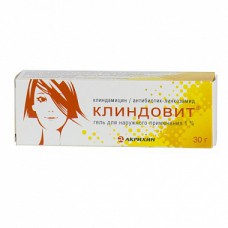Expiration date: 11/2025
The composition and form of issue:
§Gel for external use, 100 gcontains active substance:
clindamycin phosphate equivalent clindamycin 1 g
excipients: methyl parahydroxybenzoate (nipagin) allantoin disodium lauriminodipropionate Tocopheryl phosphate propylene glycol macrogol 400 (polyethylene oxide 400) carbomer copolymer sodium interpolymer hydroxide purified water
in the aluminium tube 30 g in a cardboard bundle 1 tuba.
Description of dosage form:
Gel is almost transparent, colorless with a specific smell may be opalescence.
Pharmacokinetics:
Clindamycin quickly accumulates in comedones, where it shows antibacterial activity. The average concentration of the antibiotic in the content of comedones after application of the gel is significantly higher than the IPC for all strains of Propionibacterium acnes — the causative agent of acne. After applying 1% gel of clindamycin phosphate to the skin in blood plasma and urine, very low concentrations of clindamycin are determined.
Description of the pharmacological action:
Clindamycin antibiotic group lincosamides active against all strains of Propionibacterium acnes, IPC — 0, 4 µg/ml.
Inhibits protein synthesis in the microbial cell by interaction with the 50S-subunits of ribosomes.
Clindamycin phosphate is inactive in vitro, but when applied to the skin quickly hydrolyzed by phosphatase in the ducts of the sebaceous glands with the formation of clindamycin having bacterial activity. After application to the skin, the amount of free fatty acids on the surface of the skin decreases from about 14 to 2%.
Indications:
- acne treatment (acne vulgaris).
Contraindications:
- hypersensitivity to clindamycin or lincomycin history
- Crohn disease
- ulcerative and pseudomembranous colitis (including history).
Caution: under 12 years (experience of the missing), lactation, patients with allergies while taking muscle relaxants.
Application during pregnancy and breast-feeding:
Possible cutaneous application of gel in pregnancy if the expected benefit to the mother outweighs the potential risk to the fetus. If necessary, use during lactation is recommended termination of breastfeeding.
Side effect:
The drug is usually well tolerated, but with local application of the gel may irritation (at the site of application), burning, itching, dry skin, erythema, peeling, increased sebum, contact dermatitis. In resorption, there is a possibility of development of pseudomembranous enterocolitis.
Drug interaction:
Clindamycin and erythromycin are antagonists, so it is not recommended to use these antibiotics simultaneously.
There is a cross-resistance between clindamycin and lincomycin.
May increase the effects of muscle relaxants, in violation of neuromuscular transmission.
Method of application and doses:
Outwardly.
Gel thin layer applied to the affected area of pre-cleansed and dried skin 2-3 times a day.
Course of treatment: for satisfactory results, treatment should be continued for 6-8 weeks, and if necessary, you can continue up to 6 months.
Overdose:
Data not available.
Precautionary measures:
When applying, avoid contact with the eyes and oral cavity, and after applying the gel, wash your hands.


